The Warm-Up
by Antonio J. García
Associate Jazz Editor, ITA Journal
“So what’s your warm-up?”
I’m asked that a lot. And I usually reply by saying, “I don’t have one. But I do have some music I like to practice when I first play on a given day.”
In my humble opinion, there are two dangers inherent in any warm-up routine. Some musicians may become so conditioned by that routine that they are then psychologically rattled by any setting that does not allow for their usual warm-up before the performance. This is counterproductive to fine music-making. A second concern is the potential separation of warm-up versus music. “Now I’m warming up. Sounds may come out that I’ll accept for now but wouldn’t in a performance. Later I’ll be making music.”
If it ain’t broke, don’t fix it: if your warm-up has not led to downsides, then don’t worry: be happy! But I have met many musicians who have expressed their own concerns about being “addicted” to their routines and/or being unable to “make music” until they have completed their warm-ups. Neither issue will end up on “Oprah”; but when musicians spot these concerns in themselves, we should not take them lightly.
Practicality
I remember that when I was in college, warm-ups took forever. It seemed critically important that a musician had laid aside sufficient time to run through a laundry list of musical exercises before actually playing serious music or delivering a performance.
But during those same years, I sensed an impracticality. Most of my gigs were jazz or commercial engagements, and many of them offered little or no warm-up time or space. Sure, I could buzz the mouthpiece in the car on the way to the job; but even this felt insufficient. Was there time to warm up before getting in the car? Not always possible.
I recall an older classmate of mine, Don, who was performing almost nightly at a local supper club in a posh hotel. When he returned to our school ensembles during the day he barely if ever seemed to warm up. I was in shock and utter admiration. “How do you do that? How do you play so well without the slightest opportunity to warm up?” He replied, “I’m still warm from last night’s gig.”
As my own gigs increased, I became more and more comfortable with the notion that I might not have any dedicated time or space for a warm-up. Some gigs we’d talk down the show in the bathroom or dressing room, then grab our horns, rush onto the stage, and back up the main act—often before a crowd of thousands of people who assumed that everyone on stage had been performing together for years. It was a marvelous illusion.
As I grew I of course encountered more and more musicians who seemingly had no need for a warm-up prior to the gig—and I felt more and more comfortable being one of them. Panicking when my warm-up time and/or space is unavailable before a performance is not a luxury I have. I have to be ready to perform my best regardless of the preparatory environment. And that can be a great goal. Sure, it may be more attainable as one’s playing matures; but I did get a lot better at that aspect even by the time I was 21. If one of the primary goals of practice is to “simulate game conditions” of performance, then we would be unwise to do our full warm-ups every time we practice.
At this point, I will duck so that I can avoid being hit by all the objects being thrown at me by warm-up diehards who are reading this. Before you get too incensed, allow me to clarify further.
Semantics
First, I think it’s essential that you prepare your human body well for whatever activity and/or trauma it is going to encounter. Sudden, extreme activity without preparation can lead to injury; so I recommend whatever physical movement is needed to avoid that. Don’t be foolhardy.
Second, I may play the same musical material that my fellow musicians play during their warm-ups. The difference is, while they call that material “warm-ups,” I call it “making music.” Where some individuals might feel as though they have to play a certain amount of notes before they can begin to play “real music” or play “seriously,” I play “music” from my first note. My colleagues and I might be playing the same exact notes, from the same books or from the same memory. It is a difference of semantics; but at the same time, we might have vastly different intents for the sounds we are making at first attempt.
Every note that comes out of my horn is music, good or bad. The first notes out of my horn when I take it out of the case are not notes that I play because I am obligated to play them before I might make music. The first notes that I play are music. I am using them to recapture my best sound and phrasing from the previous day, but they are music.
This sets up an expectation for me that my first notes will always be musical, whether they fall within the first moments of sound, a period before performance, or during performance. If that music—even if it’s just the note “A”—isn’t coming out as well as I want, then I focus even more on that music so as to improve it. But I’m not warming up: I’m practicing.
So as a result my performance is largely unaffected by whether or not I’ve had the opportunity to warm up. My psyche does not require it. So long as I am physically ready to play, my body is not concerned, either. I prepare that body by making music during the preparatory time that I may have. To a bystander, that may sound like exercises, excerpts, scales, or arpeggios. But to me, I am making music. It may seem subtle semantics, but the meanings are worlds apart. During my formative years, the percentage of real music that came out of my horn was embarrassingly low; so now I treasure the opportunity to make every sound its most musical.
Hopefully I can stop ducking your thrown tomatoes now. I’d also like to state that I understand the notion of, for example, doing long-tones in front of the television. I believe that many kinds of practice can lead to positive results, perhaps especially physically in that instance. But I freely say that I prefer to make music at all times the horn is on my face.
Opening Pitch
You’ll recall my answer at the opening of this article: “...I do have some music I like to practice when I first play on a given day.” So let’s explore what I do—when I have the chance.
One can categorize the elements of trombone-playing into two primary aspects: playing “with the grain” (as in glissandos) and “against the grain” (as in rips). These fundamentals are essential to good tone and flexibility; without them, any flashy techniques of tonguing and extended breathing are useless. A good follow-up to these is “stacking intervals” by pairing notes from different partials with equal emphasis in a manner that forces you to listen to your pitch, tone, and phrasing. In my view, aggressively listening to your sound, directing it, is your goal. Passively hearing your sound, playing “on automatic pilot,” is the enemy.
A long-tone, followed gradually by glisses, rips, and stacked intervals, perhaps followed by ballad tones, blues tones, or a melodic etude that includes tonguing challenges, and then maybe some broad interval leaps, constitute my usual opening salvo. I personally believe that since the purpose of my start is to become ready to perform musically, my goal is to recapture my most musical sound. Unless I have abused or neglected my embouchure by the previous day’s playing schedule, the muscles usually take only moments to “re-attune” themselves towards assisting my musical product (but that does typically follow some years of playing). I am also tuning up my musical concentration, listening to and controlling my sound. Since I am aggressively directing it, then my practicing begins on my first note; I don’t consider it “warming up.”
There will be the occasional days when the sound is detestable. I can usually attribute the poor quality to a physical condition. If I can repair it through practice, fine. If I cannot, I listen and direct the music as much as I can and remember that the human body has its ups and downs. Trombonists are no exception!
Yet we do have the capacity to make great music while the “chops” are feeling lousy. The nerves that tell the brain how our muscles feel are a different bundle than the nerves that help control our muscles’ movement. So if you can get past the unfortunate feel and focus on what sound you really want, your body can indeed accomplish some amazing things. (And we’ve all experienced the reverse as well: chops feel great, but the response is poor. That’s a signal we have to engage our brains and direct the music more, rather than being distracted.)
Long Tone
What is the note on your horn that sounds most appealing to you, a note that really resonates when you play your best? For me, that note is an “A” on the top line of the bass clef staff, a helpful choice due to its frequent use as a tuning note. Imagine the pitch and color of the chosen note. Take a guess at singing it; then (unless you have a piano nearby on which to check it) play it richly on the trombone. If it is not the pitch you sang, do not be concerned; with daily attempts, I’m betting it will soon be.
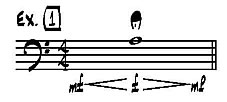
Once you are aware of the correct pitch and can imagine it in your “mind’s ear,” play it again, this time shaping it with a slight crescendo, decrescendo, or vibrato. By adding shape to the note, you are forcing yourself to listen to and control the sound. I like to vary the vibrato speed (whether slide, jaw, breath, or combination) to gain maximum control over it: be flagrant in variation!

Note that I start at a comfortable “mf” dynamic so as to increase my odds for a good beginning to the note; then I stretch the dynamic range. If your sound hesitates in coming out the horn, relax, shake your limbs out a bit, take a yawning breath, and start again. I solve my “stutter-starts” by buzzing “through” a piece of paper held in front of the horn-less mouthpiece; seeing the air move the paper guarantees the proper flow of wind needed to fuel your trombone’s sound. (I have yet to meet a troubled windplayer for whom this exploration did not yield radical improvements.) Put the mouthpiece back on the horn; and after singing the pitch and imagining the tonal color, play the pitch again, being sure to shape it.
Some of my students at this point are often more in control of their sound within the first several minutes of playing than they used to be after a half-hour of exercises. This is because it is nearly impossible to inflect personalized dynamic and vibrato shifts without truly listening to one’s sound.
I remember my first lesson with renowned Chicago Symphony Orchestra tubaist and wind-guru Arnold Jacobs back in 1980. My primary teacher, Richard Erb, had sent me to Jacobs (his own teacher) in an effort to further address my multitude of sound-production problems. As I began to play for Jacobs, my sound stutter-started awkwardly out the horn, as usual. He gently borrowed my trombone, put it up to his lips, and proceeded to play one note and then several with more slide vibrato than I’d ever used gigging on Bourbon Street in my native New Orleans. Handing me the horn back, he said, “Like that: exaggerate!” From that moment on, I moved wind through the horn like nobody’s business.
The lesson learned is this: be sure to incorporate musical elements and a musical approach into every note you play, including the first note of the day (which should not be a casually thrown-away note). If you take this involved approach, you will find yourself responding to and performing music much more quickly.
Glisses
Next I concentrate on the ultimate in legato as I listen to my tone color: glissandos. I slowly gliss with a round sound from fourth to first position, listening for the richness of every microtone, breathing after glissing back to fourth position. By incorporating a slight dynamic shift or perhaps vibrato at one end of the slide or the other, I direct myself to perform musically. I usually sustain a stronger dynamic as I ascend. The “slash marks” in the following example indicate a beat’s time passing during the movement of the gliss.
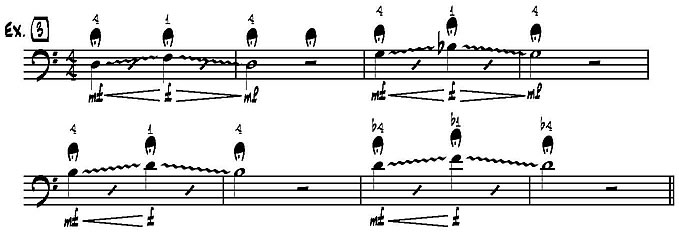
Attempt to sing each starting pitch correctly before playing it; once you can “pre-hear” the pitch, your sound on the horn will improve. Depending on your horn and mouthpiece, slide placement will vary a bit; find the correct intonation! Do not rush through the glisses to arrive at either end; music is full of microtonal adjustments you should enjoy. And if you’re a jazz musician, you will especially need control of those microtones within various vibratos. Note how my dynamic remains strong as I go higher. This can be varied, but I find that the louder dynamic aids the confidence of my students.
You will never outgrow this little piece of music, which I probably learned from Dick Erb in the 1970s. Because each subsequent gliss begins at or near the highest pitch previously played, it is a great way to expand your range. Just be sure to approach all the tones, higher or lower, with equal attention to the “mind’s ear,” imagining each to be as relaxed and easy as the first, with no special tension as notes climb. There is also a reason why I picked glisses from fourth to first positions: the intervals are all minor thirds and should assist in your summoning dark, rich tones. Imagine it to be a most mournful piece of music!
As you gain experience, you may decide to increase the tempo and play several groups of ascending glisses in one breath to improve continuity of embouchure between ranges. Eventually you might be able to cover virtually the full range of your horn, up and down, in one breath. But note that it is extremely important to complete the music descending after every ascending run. First, a lot of musical passages descend; so you’d better be prepared. Second, your entire goal is to play your upper range as if it were your mid-range; so descending tests that continuity. Third, you can expand the music below the staff (same positions) to increase your range on tenor or bass trombone. I firmly believe that the wind I move through my pedal tones allows me to blow more freely in my upper range.
Rips
Rips were long an obstacle for me, mostly because I tried to arrive instantly at a “perfect” result. I attempted to work towards it, to sneak up on it; and that approach failed for me. Success did not come until long after college. I remember attending a workshop by the gifted trombonist Bill Tole at the then-National Association of Jazz Educators conference around 1987 in which he demonstrated rips. And then I realized that I had to begin by effecting embarrassing “elephant noises,” refining them into smooth rips later on. The reason was absurdly simple: I was not moving enough wind through the horn to make a rip. (Anyone knows that elephants move lots of wind!)
Using our starting “A” as a vantage point, recapture your best long-tone, musically shaped sound. Then slowly play the following pattern, using only your wind (no tongue, except for the initial “A”) to blow across the partials; for I suggest you first play this example as beautiful music. Do not be concerned if the shift between notes is not yet as clean as it might be with use of your tongue; the whole idea is to explore articulating without the tongue. Cleanliness will come later.

Use your ears to tune the alternate positions; disregard that your eyes may give you other ideas. Once you are fairly comfortable with this, your goal is then to “rip” from the “A” to the “E” without regard for tone quality but using plenty of wind:

Repeat this (much to your neighbors’ delight) until you are fairly comfortable getting from point “A” to point “E” in crass style. Then you are ready to try a round-trip, again using no tongue except for the first note, still “quasi-elephant”:
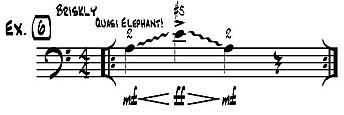
If these sounds are not coming forth, it is probably because you are not blowing enough wind. Remember that trombone novices often start by making elephant noises; so it is not a complex maneuver.
Having successfully alienated your neighbors, it is time to refine this animal into a controlled rip. Knowing now the experience of moving wind to the “E” and back, slowly repeat this pattern, using your best tone and gradually picking up speed.
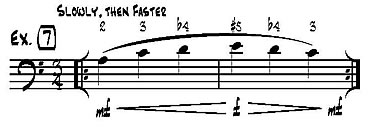
Try to find the point at which your current technique allows you to feel each note “ripple” across the partials yet in one smooth phrase. Occasionally you may need to remind yourself of proper wind (using an “elephant rip”) or tone (using a long-tone); but eventually you will take control of this aspect of playing the trombone.
This rippling process may take a bit longer than glisses to master musically, but the benefits are numerous. For one, such rips remind me where I do not have to tongue in order to yield a legato phrase. Also helpful to me is its therapeutic effect: if my playing is hesitant, filled with stutter-starts, a couple of rips will remind me how to blow wind properly to yield cooperative tones.
You will never outgrow rips, either. Though I do not recommend you try these at first, consider them for future work.


To increase your continuity of embouchure in all ranges, you can expand your rips. I have found that the low-range wind makes for great high-note results:

By choosing parts of a scale (such as the Bb scale in Example 10), you force yourself to listen to your goal lest you miss your target: pre-hear it rather than being on automatic pilot. I have found that this exploration (which I shape as music) has allowed me to play four-octave rips that I can later refine into melodic uses of the same notes in performance.
Always stay aware of your day’s limit of working on glisses and rips. There’s no need to strain. Practice them a bit, and then move on to other music. You will grow more tomorrow if you do not hurt yourself today.
Stacked Intervals
Stacked intervals give me the opportunity to combine the fluidity of glisses with the air partial-crossings of rips. In short, I am now comfortable playing with and against the grain and am ready to connect tones with a light, legato tongue. In doing so, I continue the emphasis that has already been placed on mid-range “D” and “A.” Use your tongue only on the first note and then within the same partial (where a gliss would otherwise result).
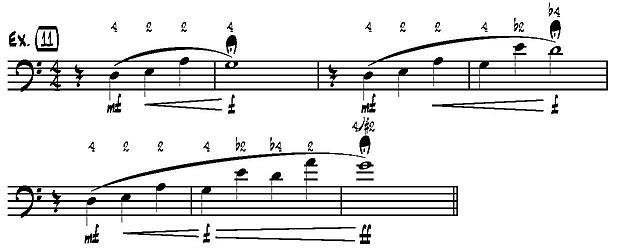
By using generous amounts of wind, you should arrive at a lovely, rich sound. Remove any stutters by repeating earlier music (all the way back to buzzing the mouthpiece, if need be). Again, you will not outgrow this music, as it can expand above and below this range. You may add vibrato, “scoops,” or other shadings as well; it is important that you shape the notes as music. (In fact, Example 11 became the basis for a three-movement jazz suite of mine; so it is not at all difficult for me to approach the motif musically.)
Example 11 stacks the intervals by limited slide positions (four and two). Hopefully, you can soon sing the anticipated pitches. I also like to slur from positions two to one, starting in the pedal register and working my way up and down.

Again, you can expand this music as far upward as you wish. And then sequence the notes down one position: from positions three to two, upward in range, then from positions four to three, etc.
Now let’s examine some stacked-interval explorations that vary the slide positions but retain constant intervals. Here’s one in perfect fourths and then in fifths; sing these as well.

These can also grow. Bring the starting point up or down a half-step. Or start with smaller intervals: minor thirds stacked, for instance, will help tune your ears to diminished chords. As you become comfortable with hearing a certain leap, move on to a new one: stack three minor sixths or two minor ninths. By picking your least-familiar intervals, you will force yourself to listen to your sound and pre-hear your pitch. Not only will your ear-training improve, you will virtually eliminate playing on “automatic pilot.”
Etudes
At this point I am ready to play a longer melody (since I consider all the previous examples merely to be shorter melodies). I recommend you play the most beautiful legato melody—classical, jazz, pop, or whatever—that you currently know well, one that you can play without written music. This in itself has proven to be a challenge for many younger students: “A melody I know”? Build that repertoire!
Concentrate during this melody on recapturing your best sound. Ad-lib a fermata here or there to study that sound. Effect vibrato or dynamic changes: direct the music-making! Then it’s time to pull out music that either is on the agenda for the next performance or parallels its challenges. I might address a high-note ballad or a fast-paced bebop tune. Or, if I have a classical performance ahead, I might address tonguing.
Tonguing
It is at this point that I add a few staccato notes to wake up my brain to that side of musical expression. I have waited this long during my opening music because I have learned that at least for me, staccato articulations will not be crisp unless I have already established a clear, musical tone and a concentrated mind. Without the tone and the mind, double, triple, or doodle-tonguing is useless. But when you’re ready, add in your favorite or needed tonguing passages.
Broad Interval Leaps
When I was studying bass trombone during my graduate years with George Osborn at The Eastman School, he coached me on the Thom Ritter George “Concerto for Bass Trombone.” I greatly enjoyed the wide-interval leaps that were a staple of the theme; so I began incorporating similar shapes into my opening practice, such as in the following example. The alternation of slide positions helps to keep my ear honest, forcing me to pay attention to each pitch.
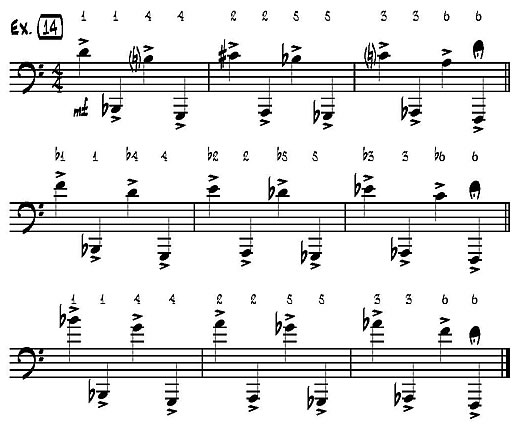
You might start not by playing pedal tones but instead the octave higher, to narrow the range; or you might leap only to an F or Bb on beat two rather than all the way to a D. These choices will make the journey easier. Or, to challenge yourself more, you can widen the top side of the interval by a partial each time you explore the music, with beat two ascending as high in first position as you wish. I find this assists in keeping my tenor-range in play while on the bass trombone and my bass-range productive while on the tenor.
Closing Pitch
So remember, I might play the same opening notes that you or your instructor might. The only difference may be that you’re “warming up” while I’m “practicing.” You might be “playing exercises” while I’m “performing music.” But if I don’t get the quiet time and space before the performance, I’m still playing the gig!
Now should we discuss “The Cool-Down?”
Antonio García is indebted to private instructors Richard Erb, John Mahoney, George Osborn, John Marcellus, and Arnold Jacobs, as well as to all his ensemble directors and professional colleagues, for their lasting, positive influence.